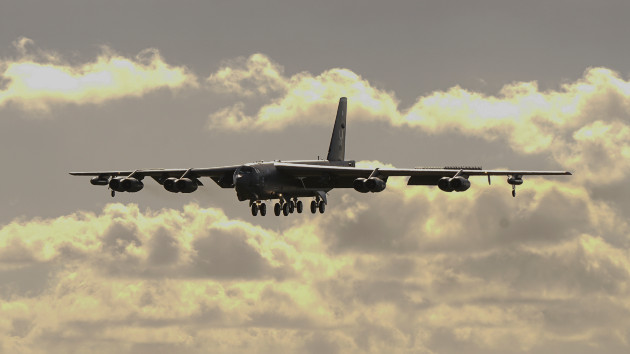US catching up to China and Russia with latest hypersonic missile test
(WASHINGTON) — The Air Force last week successfully tested a hypersonic AGM-183A missile off the coast of southern California — striking a target after reaching more than five times the speed of sound — in a sign that U.S. weapons are catching up to similar Chinese and Russian capabilities.
The missile was launched from a B-52H bomber on Friday. It’s the first test of a missile prototype that the Air Force hopes will become its first hypersonic missile.
Unlike two previous airborne tests of the missile’s booster system that reached hypersonic speeds, Friday’s test, which was announced by the Air Force on Monday, was of a full prototype with an attached warhead that struck a target after reaching hypersonic speeds.
Hypersonic weapons are designed to fly at lower altitudes than ballistic missiles while still striking at long-range targets.
The U.S. has been behind Russia and China in developing such weapons, as both countries’ militaries have already fielded hypersonic systems.
The missile the Air Force is developing is known as both the AGM-183A and the ARRW, which stands for air-launched rapid response weapon, and is intended to be fired from the air.
The test of a full prototype operational missile, or what the Air Force calls an “all-up-round” test, was similar to the two previous booster tests in that the prototype was released from a B-52 bomber flying off the coast of southern California.
“The ARRW team successfully designed and tested an air-launched hypersonic missile in five years,” Air Force Brig. Gen. Jason Bartolomei, the Armament Directorate Program’s executive officer, said in a statement. “I am immensely proud of the tenacity and dedication this team has shown to provide a vital capability to our warfighter.”
The 412th Test Wing at Edwards Air Force Base in California executed the ARRW test flight.
In addition to the air-launched hypersonic missile that the Air Force is working on, the military is also developing land-launched hypersonic weapons.
While seen as a long-distance targeting option, Russia has used some of its air-launched hypersonic missiles to strike inside Ukraine, a relatively short distance compared to its capability.
These attacks have been seen as Russia trying to demonstrate its advanced military technologies — or potentially out of need as its stock of precision-guided missiles has decreased significantly since its invasion began in February.
Though China and Russia have developed hypersonic missile systems like the ones the U.S. is working on, the term hypersonic has also been used to describe other weapons systems that operate differently.
That was the case in 2021 when it was disclosed that China had tested a system known as a fractional orbital bombardment system that could potentially carry a conventional or nuclear warhead anywhere in the world at hypersonic speeds.
In that test, China launched a rocket that carried a maneuverable glide vehicle that orbited the earth before reentering the atmosphere and traveling at a hypersonic speed toward a target.
Copyright (C) 2022, ABC Audio. All rights reserved.

